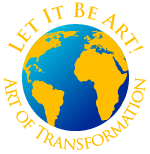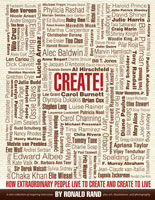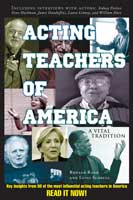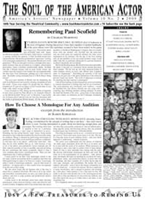





25 COUNTRIES! 20 STATES!
RONALD RAND starring as HAROLD CLURMAN
in RONALD RAND’s acclaimed Solo Performance Play
 |
 |
|
 |
 |
 |
CELEBRATING ITS 20TH YEAR! 25 COUNTRIES! 20 STATES! RONALD RAND starring as HAROLD CLURMAN in RONALD RAND’s acclaimed Solo Performance Play |
PBS American Masters |
Harold Clurman Chronology For other pages about Harold Clurman visit the following
links: Chronology1901 Harold Clurman is born at the corner of Rivington and Essex streets on the lower East Side of Manhattan on September 18th. He has three brothers. His family eventually settles in the Bronx. His father takes him to see Jacob P. Adler, the greatest Yiddish-speaking actor of the day, in Uriel Acosta. 1921
1924 Returning to New York, Clurman makes his stage debut in The Saint at the Greenwich Village Theatre for The Provincetown Players, headed by Kenneth McGowan, Robert Edmond Jones and Eugene O'Neill. 1925
1928 Working on Waldo Frank's New Year's Eve, Clurman and Strasberg begin to discuss the idea of forming their own theatre. Clurman has begun a romantic relationship with Stella Adler. 1929 Appointed as play-reader for the Theatre Guild. 1930 Beginning at 11:15 every Friday night Clurman begins a series of talks in his hotel room about the theatre for 25 weeks. "I gave an overall picture of the theatre suggesting that it be moral and spiritual. The dam burst. I realized that I fascinated people with my energy and assertiveness. As I practiced, I became aroused to a fury. Bobby Lewis gave me the name 'The Fury.' As Aline MacMahon said, "I talked the Group into existence." 1931
Four more plays are presented by the Group Theatre, including Success Story and Men in White by Sidney Kingsley, which wins the Pulitzer Prize. In the middle of the Depression, with little money and no play to do, Clurman joins Strasberg, and nine other actors and lives in a ten room cold-water flat on West 57th street, affectionately called "Groupstroy." 1934
1935
1936 Group Theatre is reorganized with Clurman as Managing Director. Group Theatre performs The Case of Clyde Griffiths. Clurman travels to Hollywood, to visit Odets and Franchot Tone. Clurman returns to New York and the Group produces its only musical, Johnny Johnson on Broadway. Stanislavski's An Actor Prepares in published in America. 1937 Rehearses Odets' Silent Partner, which is never produced. Group actors present an Actors Committee paper to the three Group directors and Strasberg and Crawford resign. Clurman and Stella Adler travel to Hollywood, where he directs his only film, Deadline at Dawn, written by Odets, starring Susan Hayward. While there, he begins writing The Fervent Years, widely regarded as the embodiment of the history of the Group Theatre and its times. Stella Adler changes her last name to Ardler to act in films. A studio executive asks Elia Kazan, who is also in Hollywood, to change his name to Cezanne. Clurman returns to New York and directs Odets' newest play, Golden Boy, which becomes the Group's biggest hit. 1938 Appoints Stella Adler as director of the Golden Boy California production. The Group presents Golden Boy in London. Awake and Sing is revived on Broadway. Clurman directs Odets' Rocket to the Moon on Broadway. In his continuing talks, Clurman emphasizes "the continuity of effort signifying the building of tradition, the foundation of a true culture.without some dependence on his tradition, the artist starts his new work with an always decreasing stock, till he ends with a shadow or memory of himself, not a consummation. We lack memory. We cancel our experience." 1939 Directs Irwin Shaw's The Gentle People. In the summer, he begins rehearsals on The Three Sisters with Group actors, which is never produced. The war begins in Europe. 1940 Directs Odets Night Music on Broadway, and with final Group production, Retreat to Pleasure, the Group Theatre closes. 1942-1947
1948-1949 Travels to Tel Aviv and directs Emmanuel Robles' Montserrat. Begins writing for the weekly magazine, "The New Republic," continuing for the next four years. Directs Arthur Laurents' The Bird Cage. 1950 Directs Carson McCuller's The Member of the Wedding, with Ethel Waters, Julie Harris, and Brandon de Wilde, winning the Donaldson Award for best director. Around this time, he begins teaching late evening classes. those attending these late evening sessions include Colleen Dewhurst, Eli Wallach, Anne Jackson, Kim Stanley, Julie Harris, Elizabeth Wilson, Elaine Stritch, and Maureen Stapleton. 1951-1953 Directs Lillian Hellman's The Autumn Garden, the revival of Eugene O'Neill's Desire Under the Elms, Arthur Laurents' The Time of the Cuckoo, George Tabori's The Emperor's Clothes. Begins writing for the weekly magazine, "The Nation". Directs Jean Anouilh's Mademoiselle Colombe. 1954 Directs William Inge's Bus Stop with Kim Stanley and Elaine Stritch. 1955-1959 Directs Jean Giraudoux's Tiger at the Gates, translated by Christopher Fry (in London and New York), with Michael Redgrave; Richard Rodgers and Oscar Hammerstein's musical, Pipe Dream; the revival of Jean Anouilh's farce, The Waltz of the Toreadors with Ralph Richardson and Mildred Natwick; Tennessee Williams' Orpheus Descending with Maureen Stapleton, Lois Smith and Cliff Robertson; The Day the Money Stopped by Maxwell Anderson and Brendan Gill; the revival of The Cold Wind and the Warm with Eli Wallach and Maureen Stapleton; and Eugene O'Neill's A Touch of the Poet with Kim Stanley, Helen Hayes and Eric Portman. Receives first George Jean Nathan Award as Drama Critic for "The Nation," and for his book, Lies Like Truth. 1959 Travels to Tel Aviv to direct George Bernard Shaw's Caesar and Cleopatra. 1960-1962 Marries Juleen Compton, an actress/filmmaker half his age. Directs Jean Anouilh's Jeanette, the revival of Shaw's Heartbreak House, A Shot in the Dark by Harry Kurnitz and Marcel Archard, Jean Giraudoux's Judith, translated by Christopher Fry (in London). 1965
1966-1969 Directs William Inge's Where's Daddy? Returns to Tokyo to direct The Iceman Cometh. Directs Anton Chekhov's Uncle Vanya with Joseph Wiseman at The Mark Taper Form in Los Angeles. 1970-1972 Begins his association as a professor at Hunter College in New York City, where he will teach courses on the theatre for the next decade. On Directing is published. 1974-1977 A collection of his essays is published, entitled The Divine Pastime. His autobiography, All People are Famous is published. It ends with ".I believe that life is essentially irrational, but I also believe that human beings must use their reason - with due recognition of its limitations. I believe that men and women may not be perfectible, but they must act as if they were. I believe that although we may not possess free will, we must behave as if we did. I believe life terrible and glorious." 1978-1980
1994 The Essential Harold Clurman (Commentary on Theatre, Acting, Directing, Criticism and Playwriting) is published by Applause Books. Aaron Copland writes: "Our finest writer on the theatre. To read Clurman, is to view the art of theatre with a new sense of elation." Timeline created by Ronald Rand | Top | For other pages about Harold Clurman visit
the following links:
|
 |
© Copyright Ronald Rand 2003. All rights reserved.
|